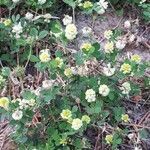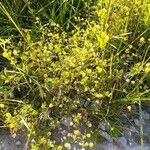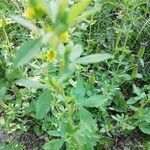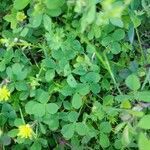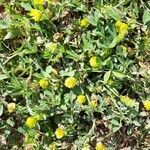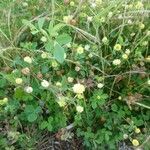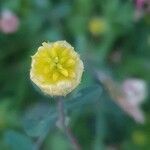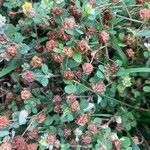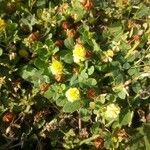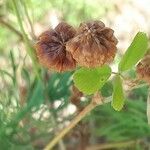Annual herbs, pubescent to glabrescent. Stems erect, ascending, or prostrate. Leaves pinnately 3-foliolate; stipules ovate to oblong, 5-8 mm, adnate to petiole for 1/2 their length, apex acuminate; petioles shorter than or equal to leaflets; lateral leaflets sessile, terminal petiolule 3-7 mm; leaflets obovate to oblong-elliptic, 8-16 × 4-8 mm, lateral veins 5-8 pairs, base cuneate, margins entire proximally, serrate distally, apex rounded to emarginate. Flowers 20-40, imbricate in globose or cylindric racemes, 8-13 × 7-10 mm; peduncle 1-3 cm; involucre and bracts absent; pedicels 1-1.8 mm, reflexed after anthesis. Calyx white, 2-2.8 mm, membranous, glabrous to sparsely pubescent, veins 5. Corolla yellow, turning brown, (3-)5-6 mm; standard broadly spatulate, striate, apex emarginate. Legume long ovoid, ca. 3 mm; stipe ca. 1 mm. Seed 1, brown, convex-ovoid, ca. 1 mm. Fl. and fr. Feb-Apr.
Annual, much-branched, 1–4 dm, the stem pubescent; petioles 8–12 mm, twice as long as the obliquely ovate stipules; lfls oblong-obovate, 8–15 mm, the terminal one on a stalk 1–3 mm; heads globose to short-cylindric, 8–15 mm, compact, with usually 20–30 fls; fls 3.5–5 mm; cal as in no. 15 [Trifolium aureum Pollich]; cor yellow, the standard obovate, with 5 conspicuous diagonal veins on each side, much exceeding the spoon-shaped, slightly divergent wings; 2n=14. Native of Eurasia and n. Afr., established as a weed along roadsides and in waste places throughout much of N. Amer. May–Sept. (T. procumbens, a rejected name)
Corolla 5–7 mm long, pale yellow fading to pale brown; standard orbicular, flattish or spoon-shaped when in fruit, entire or slightly retuse at the apex, denticulate at margin, markedly longitudinally sulcate, persistent, ± twice as long as the claw; wings sinuate-oblong, rounded at the apex, twice as long as the claw, the auricles separated from the claw by a broad, square sinus; keel oblong, obtuse or slightly acuminate, twice as long as the claw.
Leaves petiolate; leaflets 6–12 × 4–8 mm, obovate, emarginate or retuse at the apex, the midrib pilose beneath but otherwise glabrous, nervation straight; petioles 1–1.5 cm long in the lower leaves, reducing above; stipules ovate to oblong, long-acuminate.
Calyx c. 2 mm long, white, 5-nerved, glabrous; tube membranous; teeth very unequal, the two upper very short, triangular or lanceolate, the others long, linear, twice as long as the tube or longer, long-subulate.
A low annual herb. It grows 50 cm tall. It is usually much branched. The leaflets are oblong. The flowers are 3.5-5 mm long. They are yellow. They are in round heads.
Inflorescence rounded or ovoid, many-flowered; peduncle usually exceeding the subtending leaves.
Flowers with pedicels c. 1 mm long, becoming deflexed early.
Pod oblong, stipitate, enclosed within the keel, 1-seeded.
Seeds c. 1 mm long, ovoid, chestnut-brown, smooth.
Stems erect or ascending, hairy.
Annual herb.
